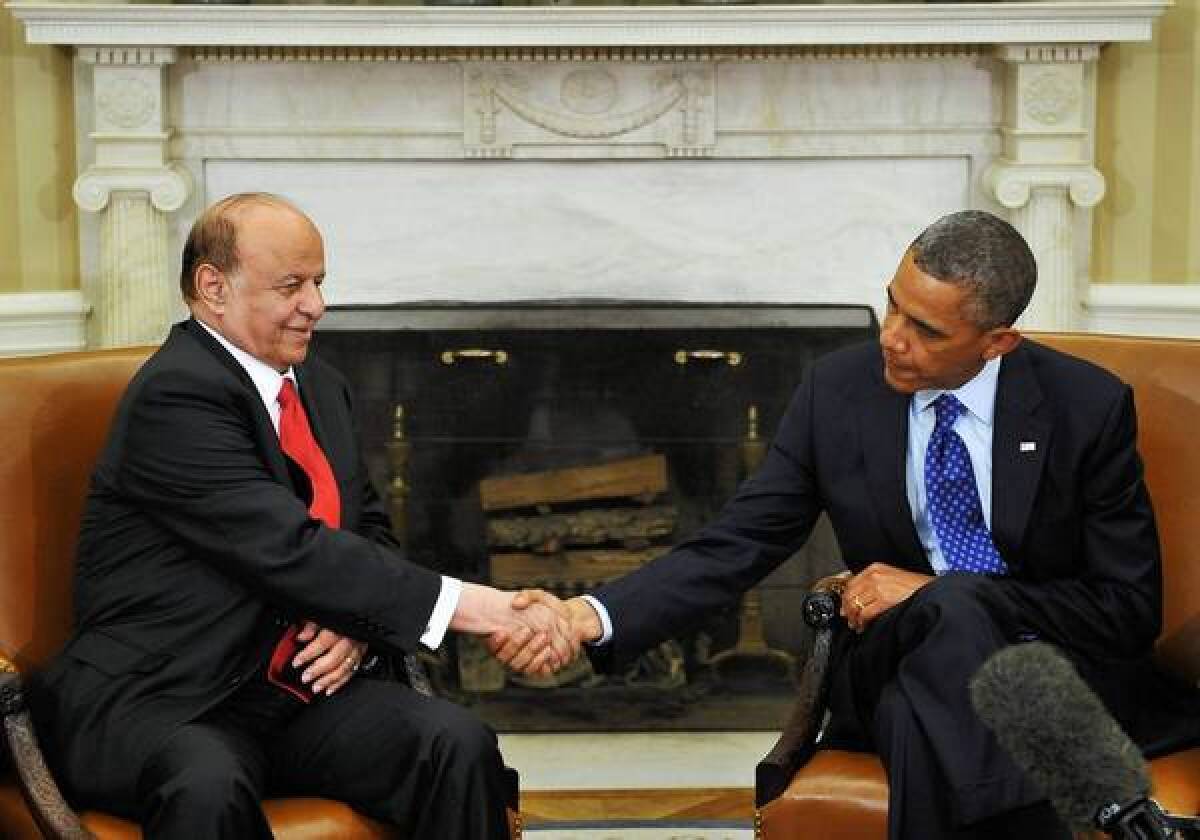Drone strike campaign in Yemen shows U.S. standards are elastic

- Share via
WASHINGTON — A surge of U.S. drone missile strikes that has killed about 40 suspected militants in Yemen over the last three weeks may appear inconsistent with President Obama’s pledge in May to use drone aircraft to target and kill only individual terrorists who pose a continuing and imminent threat to Americans.
White House officials say the targeting rules haven’t changed for the 10 recent drone strikes. But analysts and former U.S. officials say the current campaign, after the pace of attacks had slowed, shows that the standards are elastic.
They say the wave of attacks highlights Obama’s willingness to accelerate lethal operations in response to terrorist threats, even though intelligence on the latest plot was imprecise about the timing or location of apparent targets.
“The tendency had been ‘less is more’ in terms of these strikes, and I think we’ll go back to that,” said a former U.S. diplomat who served in Yemen, but who asked for anonymity because the drone strikes are classified. “But at the moment, when you have guys on the move and a plot in the works, there is a bias toward taking as many whacks at them as you can and seeing if you can’t knock them on their heels.”
A Yemeni official who asked not to be quoted speaking about sensitive matters, said the U.S. strategy amounted to “keep them busy, keep them hiding, put them under pressure.”
Yemeni President Abdu Rabu Mansour Hadi met with Obama in the Oval Office on Aug. 1, and has publicly endorsed America’s drone campaign in his country. The tempo of the latest airstrikes, which began July 27, picked up sharply after his visit.
U.S. officials have not publicly identified those targeted since Hadi’s visit, but acknowledge that no senior Al Qaeda leaders have been killed. Yemeni officials say only a few of the dead appear to be on a list of 25 “most-wanted terrorists” that the government in Sana distributed this month.
In an Aug. 8 strike in the Wadi district of Marib province, a family member said two teenagers were killed.
Arfag Marwani said in a telephone interview that his younger brothers Hussain, 16, and Hassan, 17, were shopping when the missile hit. He denied that they were terrorists, though he said the third victim might have been a militant.
“The drone hit them ... without any good reason,” Marwani said.
Obama declined to discuss the drone strikes in Yemen at a White House news conference on Aug. 9.
“I will not have a discussion about operational issues,” he said. He referred reporters to a speech he gave May 23 at the National War College about “how we make these determinations about potential lethal strikes.”
In the speech, Obama said, “We act against terrorists who pose a continuing and imminent threat to the American people, and when there are no other governments capable of effectively addressing the threat. And before any strike is taken, there must be near-certainty that no civilians will be killed or injured — the highest standard we can set.”
Critics say it’s difficult to see how the current wave of attacks is meeting that strict standard, or why greater efforts aren’t underway to capture rather than kill the suspects.
“This looks a lot like they are bombing and hoping,” said Gregory Johnsen, author of “The Last Refuge: Yemen, Al Qaeda, and America’s War in Arabia.” “It’s not clear they know who they are hitting.”
U.S. officials dispute that, but refuse to discuss their targeting decisions. The latest drone strikes bring the total in Yemen so far this year to 22. That compares with 42 last year.
Caitlin Hayden, a spokeswoman for the National Security Council, said the attacks are consistent with the language and principles that the president outlined in his May speech.
Obama presented “the legal rationale that underpins our operations and the constraints that guide them. Those remain in place,” she said.
“The president did not say that our need for direct action would necessarily be lessened in the future,” she said. “He made clear, however, that under his new policy guidance the use of drones is heavily constrained.”
In recent months, White House officials have promised to bring greater transparency to the use of armed drones outside war zones. So far, that hasn’t happened.
In May, they said they would gradually transfer the drone campaign from the CIA, which has the lead in Yemen, to the Pentagon’s Joint Special Operations Command, which also conducts drone strikes in Yemen but operates under laws that allow for acknowledgment of lethal operations.
That transfer has not yet begun, U.S. officials now say, and may not happen for years.
A Pentagon spokesman, James Gregory, said the U.S. military has worked with Yemen’s military “to respond to ongoing threats.” He said they have put “unprecedented pressure” on Al Qaeda in the Arabian Peninsula, the terrorist group based in Yemen, and “that pressure has helped disrupt ongoing plots.”
Times staff writer David S. Cloud in Washington and special correspondent Shuaib Almosawa in Sana, Yemen, contributed to this report.
More to Read
Sign up for Essential California
The most important California stories and recommendations in your inbox every morning.
You may occasionally receive promotional content from the Los Angeles Times.











